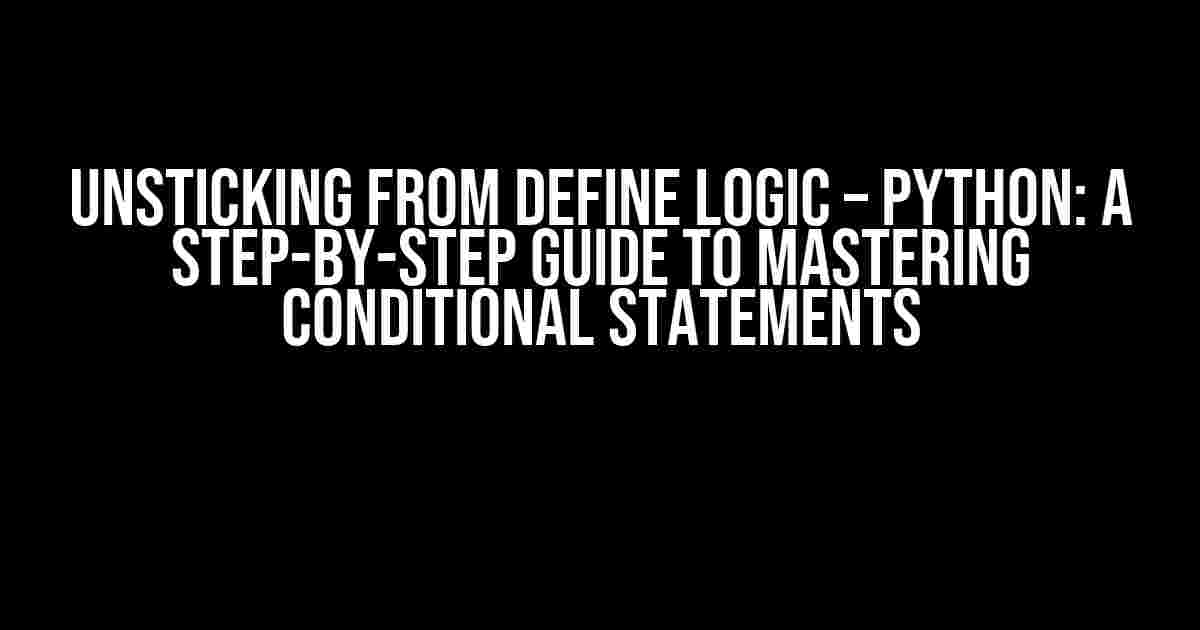Are you stuck with define logic in Python? Do conditional statements confuse you? Fear not, dear programmer! This comprehensive guide will take you by the hand and walk you through the world of Python’s define logic, helping you master the art of conditional statements.
Understanding Conditional Statements
Conditional statements are the backbone of any programming language. They allow your code to make decisions based on certain conditions, making it more dynamic and interactive. In Python, conditional statements are used to control the flow of your program.
If-Else Statements
The most basic type of conditional statement in Python is the if-else statement. It’s used to execute a block of code if a certain condition is true, and another block of code if the condition is false.
if condition:
# code to execute if condition is true
else:
# code to execute if condition is false
Let’s break it down:
if: The keyword used to start the conditional statement.condition: The expression that is evaluated to determine whether the code should be executed or not.code to execute if condition is true: The block of code that will be executed if the condition is true.else: The keyword used to specify the alternative block of code to execute if the condition is false.code to execute if condition is false: The block of code that will be executed if the condition is false.
Examples
Let’s see some examples to make it clearer:
# Example 1: Simple if-else statement
x = 5
if x > 10:
print("x is greater than 10")
else:
print("x is less than or equal to 10")
# Example 2: If-else statement with multiple conditions
y = 10
if y > 5:
print("y is greater than 5")
elif y == 10:
print("y is equal to 10")
else:
print("y is less than 5")
Elif Statements
Elif statements are used to check multiple conditions in a single if-else statement. They allow you to specify multiple conditions to check, and execute different blocks of code based on which condition is true.
if condition1:
# code to execute if condition1 is true
elif condition2:
# code to execute if condition1 is false and condition2 is true
else:
# code to execute if both condition1 and condition2 are false
Examples
Let’s see some examples:
# Example 1: Simple elif statement
x = 10
if x > 15:
print("x is greater than 15")
elif x == 10:
print("x is equal to 10")
else:
print("x is less than 10")
# Example 2: Multiple elif statements
y = 20
if y > 25:
print("y is greater than 25")
elif y == 20:
print("y is equal to 20")
elif y < 20:
print("y is less than 20")
else:
print("y is undefined")
Nested Conditional Statements
Nested conditional statements are used to check conditions within conditions. They allow you to create complex logic structures that make your code more dynamic and efficient.
if condition1:
if condition2:
# code to execute if both condition1 and condition2 are true
else:
# code to execute if condition1 is true but condition2 is false
else:
# code to execute if condition1 is false
Examples
Let’s see some examples:
# Example 1: Simple nested conditional statement
x = 10
y = 20
if x > 5:
if y > 15:
print("Both x and y are greater than their respective values")
else:
print("x is greater than 5, but y is not greater than 15")
else:
print("x is not greater than 5")
# Example 2: Multiple nested conditional statements
z = 30
if x > 5:
if y > 15:
if z > 25:
print("All three conditions are true")
else:
print("x and y are true, but z is not true")
else:
print("x is true, but y is not true")
else:
print("x is not true")
Login System Example
Let’s create a simple login system using conditional statements:
username = input("Enter your username: ")
password = input("Enter your password: ")
if username == "admin" and password == "password123":
print("Login successful!")
else:
if username == "admin" and password != "password123":
print("Incorrect password. Try again!")
elif username != "admin" and password == "password123":
print("Incorrect username. Try again!")
else:
print("Both username and password are incorrect. Try again!")
This login system checks for two conditions: the username and the password. If both are correct, it prints “Login successful!”. If either one is incorrect, it prints an error message accordingly.
| Username | Password | Output |
|---|---|---|
| admin | password123 | Login successful! |
| admin | wrongpassword | Incorrect password. Try again! |
| wronguser | password123 | Incorrect username. Try again! |
| wronguser | wrongpassword | Both username and password are incorrect. Try again! |
Best Practices
When working with conditional statements, it’s essential to follow best practices to make your code more readable, maintainable, and efficient:
- Use clear and concise variable names.
- Keep your conditional statements simple and easy to understand.
- Avoid using multiple nested conditional statements if possible.
- Use elif statements instead of multiple if statements.
- Test your code thoroughly to catch any logical errors.
Conclusion
Mastering conditional statements is a crucial part of becoming a proficient Python programmer. By following the guidelines and examples provided in this article, you’ll be well on your way to creating complex logic structures that make your code more dynamic and efficient.
Remember, practice makes perfect! Experiment with different conditional statements, and soon you’ll be unstuck from define logic in Python.
Frequently Asked Question
Get unstuck with defining logic in Python!
Q1: What is logical AND (and) in Python?
In Python, the logical AND operator is denoted by the keyword “and”. It returns True if both conditions are true, and False otherwise. For example: `if x > 5 and x < 10: print("x is between 5 and 10")`
Q2: How do I use the logical OR (or) operator in Python?
In Python, the logical OR operator is denoted by the keyword “or”. It returns True if at least one condition is true, and False otherwise. For example: `if x > 5 or x < 10: print("x is either greater than 5 or less than 10")`
Q3: What is the NOT (not) operator in Python?
In Python, the logical NOT operator is denoted by the keyword “not”. It returns True if the condition is false, and False otherwise. For example: `if not x == 5: print(“x is not equal to 5”)`
Q4: How do I chain multiple logical conditions in Python?
In Python, you can chain multiple logical conditions using the and, or, and not operators. For example: `if x > 5 and x < 10 or x == 15: print("x meets the condition")`
Q5: Can I use parentheses to group logical conditions in Python?
Yes, you can use parentheses to group logical conditions in Python. This helps to clarify the order of operations and make the code more readable. For example: `if (x > 5 and x < 10) or (y == 15): print("x and y meet the condition")`




![No Data is Present After Deployment [Render]: A Comprehensive Troubleshooting Guide No Data is Present After Deployment [Render]: A Comprehensive Troubleshooting Guide](https://geno.hkhazo.biz.id/wp-content/uploads/sites/438/2024/07/no-data-is-present-after-deployment-render-a-comprehensive-troubleshooting-guide-with-text-300x300.jpg)